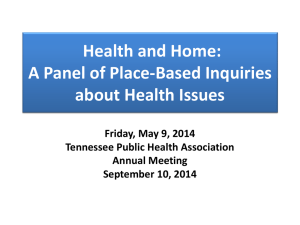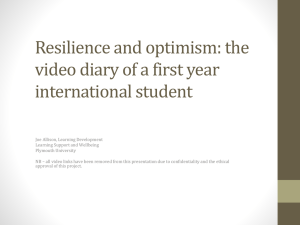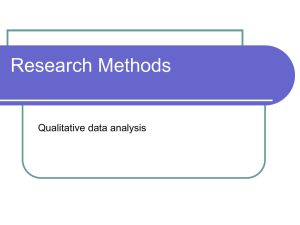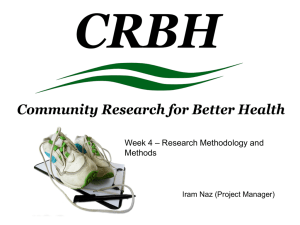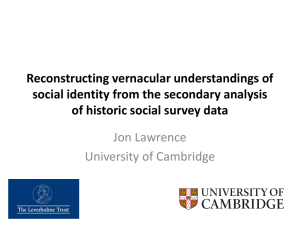The Importance of Qualitative Research in Mixed Methods
advertisement
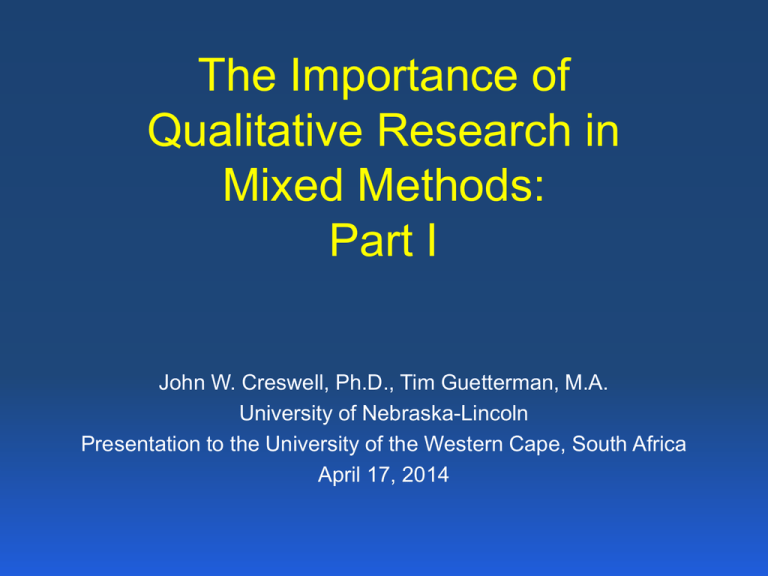
The Importance of Qualitative Research in Mixed Methods: Part I John W. Creswell, Ph.D., Tim Guetterman, M.A. University of Nebraska-Lincoln Presentation to the University of the Western Cape, South Africa April 17, 2014 Topics 2 Use of qualitative research in mixed methods Key features of qualitative research Types of problems addressed through qualitative research Philosophical assumptions Qualitative purpose statements and research questions Qualitative data collection Qualitative data analysis and software Validation/accuracy How Qualitative Research Fits into Mixed Methods Useful in Providing multiple perspectives Explaining quantitative results Exploring before administering an instrument Validating quantitative results Hearing participant views Understanding process in evaluation Key Features of Qualitative Research Follow the scientific method (e.g., problem, questions, method, results) Listen to participants’ views Ask open-ended questions Build understanding based on participants’ views Develop a complex understanding of the problem Go to the setting to gather data Be ethical Analyze data inductively-let findings emerge Write in user-friendly, literary way Include rich quotes Researcher presence in the study Types of Problems Need to explore Important to listen to participants Unusual culture, sample Do not know questions to ask Understand process Need to tell a story Philosophical Assumptions: Worldview, Beliefs, Values Issue Post-positivism Critical Theory Constructivism Ontology Critical realism-”real” reality but only imperfec and probabilistic. Historical realismRelativism-local and virtual reality shared by specific co-constructed social, political, realities. cultural, economic, ethnic, and gender values. Participatory Participative realitysubjective-objective reality, co-created by minds. Epistemology Modified dualist/objectivist; critical tradition/community; findings probably true. Transactional/subjectiv Transactional/subjectiv Critical subjectivity in ist; value-mediated ist; co-created findings. participatory findings. transaction; experiential, propositional, and practical knowing; cocreated findings Methodology Dialogic/dialectical Modified experimental/manipula tive; critical multiplism; falsification of hypotheses; may include qualitative methods Hermeneutical/dialecti cal Adapted from Lincoln, Lynman, & Guba , 2011 Political participation in collaboration; primacy of the practical; use of language grounded in shared context. How are philosophies implemented? Multiple realities Subjectivity Explicit values Emerging design Language is personal Writing a Good Qualitative Purpose Statement 8 What it includes: Single sentence “The purpose of this study . . .” Central phenomena Qualitative words (e.g. explore, understand, discover Participants Research site Sample Purpose Statement Script Purpose Statement Script: “The purpose of this qualitative study (replace later with type of qualitative approach later) will be to ______(understand, describe, develop, discover) the ________(central phenomenon) for _______(participants: person, process, groups) at ______________(site) Qualitative Qualitative Purpose Statement Approach What I hope Example to do in the study Central Phenomenon We therefore conducted a qualitative study to Participants explore the care seeking behaviour, access to Site treatment, and knowledge and perceptions about TB among men and women of The Gambia, West Africa. Definition of Central Phenomenon ? Eastwood & Hill, 2004 Understanding a central phenomenon 11 Quantitative Explaining or predicting variables X Qualitative Understanding or exploring a central phenomenon Y Y The independent variable (X) influences a dependent variable (Y) In-depth understanding of Y; external forces shape and are shaped by Y 12 Qualitative Research Questions Open-ended Broad 1 or 2 central questions 5 to 7 subquestions Single phenomenon Exploratory verbs Participants and site Sample Script for the Central Question 13 ___(How or what) is the ___ (“story for” for narrative research; “meaning of” the phenomenon for phenomenology; “theory that explains the process of” for grounded theory; “culture-sharing pattern” for ethnography; “issue” in the “case” for case study) of ___ (central phenomenon) for ___ (participants) at ___ (site)? Qualitative Central Question Example 14 What is the theory that explains the process of accessing TB services among women of The Gambia? 15 Methods for a Qualitative Study Data collection Data analysis Data representation Data interpretation Validation strategies Data Collection Sampling (purposeful) Site selection (gate keepers, permissions) Recruitment (incentives) Types of data (observation, interview, public/private documents, audiovisual) Locating Site/Individual Gaining Access and Making Rapport Storing Data Resolving Field issues Purposefully Sampling Recording Information Collecting Data 17 Interview Types Decide on the type of interview to use Individual Focus group Telephone e-mail 18 Interview Procedures Create an interview protocol Ask open-ended questions (5-7) allows the participant to create options for responding participants can voice their experiences and perspectives If possible, record and transcribe for analysis Interview Protocol for (Title of Study) Interviewer: Interviewee: Date: Time: Place: Interviewer Introduction Start Recording The purpose of this study is (briefly describe purpose} Interviewee information: (e.g., position, role) Questions: 1. What… 1. What… Closing Comments (Write out comments and thank the participant for the interview) Observations Create an observational protocol Record descriptive notes Record reflective notes Decide on your observational stance Enter site slowly Conduct multiple observations Summarize at end of each observation Observation Protocol for (Title of Study) Date: Time: Place Descriptive Notes Reflective Notes (Portrait of informant, physical setting, event description) (Personal reflections, insight, ideas, confusion, hunches, initial interpretation) Types of Audio-visual Materials Examine physical trace evidence (e.g., footprints in sand or snow) Videotape or film a social situation, individual, or group Examine website main pages Collect sounds Collect email or social network messages (e.g., Facebook, Twitter) Examine favorite possessions or ritual objects Steps in Qualitative Data Analysis Reading through databases (margin notes) Checking accuracy of account (validity) Coding Representing findings (figures, theme passage) Collapsing codes into themes Interrelating themes Common Software Packages Available MAXQDA NVIVO Atlas.ti HyperResearch How to Code Initially read Divide text Label through data into segments segments of of information information with codes Many Pages of Text Reduce Overlap and redundancy of codes Many 30-40 Codes Segments codes reduced of Text to 20 Collapse codes into themes Reduce Codes to 5-7 Themes How to Code Theme Code Term Select Climbing Wall Narratives, Fall, 2011, Section 002, #1 As I walked into the gym, I was bombarded with the smell of old gym shoes, a smelly locker that had seen the many wins and losses of a team. Around me was a juxtaposition Physical Physical of sights. The old wood floors and brick foundation of the description description gym did not fit with what was inside; badminton nets, an open view of different workout rooms, and lastly a climbing of wall wall. The climbing wall was separated by two activities: instruction and climbing. To the left of the wall, an instructor was giving a tutorial, with a typed handout, on how to use the necessary equipment to climb. The new climbers were asked to read a portion of the handout, as the instructor Instructor provided a visual demonstration on the equipment. The new climbers asked questions regarding the handout and the demonstration. This process continued for some time; a detailed process, yet very relaxed and informal. Another instructor came in, wearing jeans and a tank top. Process of climbing How to Write a Theme Passage Safety In vivo theme title Codes build evidence for themes Use of quotes The violence in the city that involved university students and the subsequent gun incident that occurred in a campus classroom shocked the typically tranquil campus. A counselor aptly summed up the feelings of many: “When the students walked out of that classroom, their world had become very chaotic; it had become very random, something had happened that robbed them of their sense of safety.” Concern for safety became a central reaction for many informants. When the chief student affairs officer described the administration’s reaction to the incident, he listed the safety of students in the classroom as his primary goal, followed by the needs of the news media for details about the case, helping all students with psychological stress, and providing public information on safety. As he talked about the safety issue and the presence of guns on campus, he mentioned that a policy was under consideration for the storage of guns used by students for hunting. Within 4 hours after the incident, a press conference was called during which the press was briefed not only on the details of the incident, but also on the need to ensure the safety of the campus. Soon thereafter the university administration initiated an informational campaign on campus safety. A letter, describing the incident, was sent to the university board members. (One board member asked, “How could such an incident happen at this university?”) Figure 3. Data analysis to build a theme (Asmussen & Creswell, 1995, pp. 582-584) Sources of information Major Validation Strategies 28 Member checking: Members check the accuracy of the account Triangulation: Looking for themes across different types of data; different researchers; different participants Others: peer review, external audit, report disconfirming evidence, clarify researcher’s stance, thick description, prolonged time in the field Writing the Qualitative Research Study Description 5-7 themes (including multiple perspectives, good quotes, useful dialogue, even metaphors or analogies) Detail Realistic, note tensions/contradictions Engaging/persuasive/storytelling Checklist for a Rigorous Qualitative Study General: ___ Provide a rationale for why qualitative research is well-suited for studying the research problem (e.g., participant views, context, complex understanding, lack of known variables, capturing voices) ___ Describe the type of qualitative research design (e.g., narrative research, phenomenology, grounded theory, ethnography, or case study) that will be used ___ Explain why the design is well-suited to address the problem Qualitative Data Collection: ___ Discuss the site(s) that will be studied ___ Identify permissions that have been granted (include something about IRB permissions) ___ Indicate how participants will be recruited to the study ___ N of participants ___ Discuss the type of purposeful sampling to be used (inclusion criteria) ___ Demographics of participants ___ Indicate how the participants will benefit from the study (reciprocity) ___ Indicate the types of data to be collected (perhaps a table of data collection?) ___ Indicate the extent of data collection ___ Mention the use of protocols (interview, observations, records) used to record the data ___ State the research questions that will be asked (if interviews occur) Checklist for a Rigorous Qualitative Study (continued) Data Analysis: ___ Discuss preparing the data (transcriptions) ___ Indicate the general procedure of data analysis (reading through the data and writing memos, coding the data, description, developing themes, interrelating the themes) ___ Indicate any specific procedures related to the approach to qualitative research (e.g., in grounded theory, use open coding, axial coding, and selective coding) ___ Discuss the use of qualitative data analysis software to help analyze the data (e.g., MAXQDA, etc.) ___ Discuss use of multiple coders (i.e., intercoder agreement) if used in the study and how this process was accomplished with the percent agreement ___ Discuss validity strategies (e.g., member checking, triangulation, negative case analysis, peer audit, external audit, immersion in the field) ___ Discuss reflexivity—how the researchers’ experiences and role will influence the interpretation of findings. Topics 32 Use of qualitative research in mixed methods Key features of qualitative research Types of problems addressed through qualitative research Philosophical assumptions Qualitative purpose statements and research questions Qualitative data collection Qualitative data analysis and software Validation/accuracy Questions Asked 33 Journal to publish in Online course to learn about Use of theory Funding sources for projects Convincing faculty advisors Variation in how to write up Marshall and Rossman, 2011 Key Readings Bazeley, 2013 Kuckartz, 2014 Saldana, 2013 Creswell & Guetterman, 2015 Qualitative journals: http://www.slu.edu/organizations/qrc/QRjournals.html The Importance of Qualitative Research in Mixed Methods: Part I John W. Creswell, Ph.D., Tim Guetterman, MA University of Nebraska-Lincoln Presentation to the University of the Western Cape, South Africa April 17, 2014


